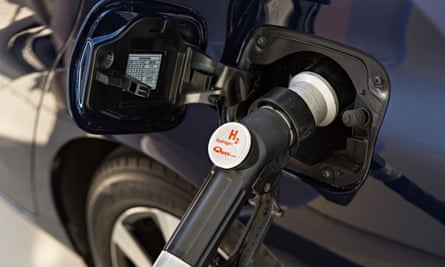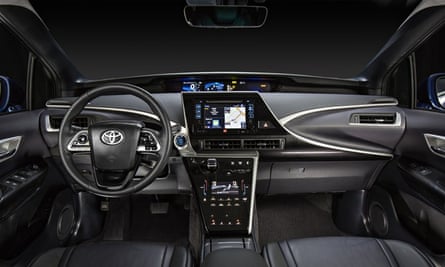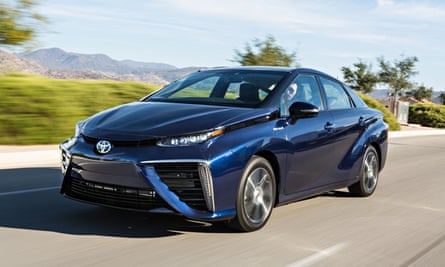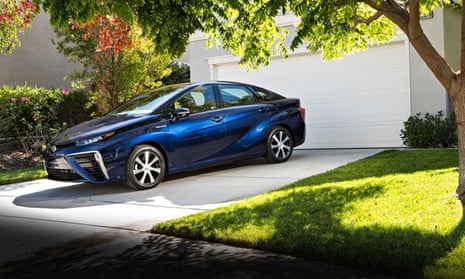From the driver’s seat of the Toyota Mirai, the world’s first mass-produced hydrogen fuel cell car could be a plusher and more powerful version of the Prius – if it wasn’t for the H20 button on the dash which releases a trickle of water.
Until now, car companies have been slow to bring hydrogen fuel cell vehicles to market. But Toyota is betting on the Mirai (‘future’ in Japanese) to emerge as the next generation of green car.
For that to occur, the four-seater sedan will need to replicate the success of the Prius in taking the offbeat technology of a gas-electric hybrid engine and making it middle of the road within the space of only a few years. The Prius is now the top-selling car in California.
The Mirai goes on sale in Japan in December, and in the US and Europe in the second half of 2015.
The initial release will be limited - just 700 globally, with only 50-100 expected to be shipped to the UK, Germany and Denmark in Europe.
The car will sell for $69,000 (£44,000) in Japan, $57,500 in the US and €66,000 (£52,000) in Europe. In the US, a package of government subsidies could bring the price down to about $45,000. But even at those high prices, Toyota is still losing money on each car, analysts said.
The hydrogen fuel cells power electric motors like battery-powered vehicles do. But instead of storing the energy in a battery pack, the fuel cell vehicles store hydrogen gas in an onboard tank that can be refilled in minutes, just like a gas tank.
The car has a number of advantages over electric vehicles.
Hydrogen can power bigger vehicles – the former governor, Arnold Schwarzenegger, famously converted his Hummer to hydrogen.

Fuel cell vehicles have a longer range. Toyota says the Mirai can run about 300 miles on a single tank of compressed hydrogen, compared to about 75 miles for most electric vehicles, and – unlike electric vehicles – the Mirai can be refuelled in minutes from compressed hydrogen.
In case of a natural disaster or other emergency a full tank produces enough electricity to power the average home for close to a week.
But Toyota executives admit the Mirai will be a different and a harder sell than the Prius.
Once you have purchased the Mirai, where do you fill it up? So far, there are barely a dozen hydrogen fuelling stations in California, all but one clustered around the Orange County area.
“In the case of the Prius, as an automaker we had to work really hard to sell more Priuses, and so forth, but that was it,” said Satoshi Ogiso, the managing officer. “For fuel cell vehicles, it’s not only the vehicle sales. We also have to make sure the infrastructure is in place.”
To fill the gap, Toyota is prepared to offer its customers in California free fuel for months, if not years. The car maker also announced plans this week to partner with Air Liquide, a global producer of hydrogen, to develop fuelling stations in north-eastern states before the cars go on sale there in 2016.
But Toyota says it remains convinced that the car, whose only emissions are the water vapours from its tailpipe, will thrive in a carbon-constrained future. It says it intends the Mirai to be the first of an entire line-up of hydrogen fuel cell vehicles.
“Prius broke down barriers. The hydrogen fuel cell technology in the new Mirai will do the same,” the company’s chairman, Takeshi Uchiyamada, said.
Not everyone agrees. The Obama administration over the last six years has offered financial support to electric vehicles, while phasing out government supports for hydrogen. Elon Musk, the founder of Tesla, famously dismissed the idea of hydrogen cars as rubbish.
But a number of car makers are beginning to pay more attention to hydrogen technology. Honda said this week it would begin sales of its hydrogen car in 2016. Hyundai has started leasing a fuel cell version of its Tucson SUV in California. Ford, Daimler, Renault and Nissan are working to develop a joint fuel cell technology project.
Newport Beach – where the multi-layer yachts in the harbour look like floating wedding cakes – may not seem the obvious hub for the hydrogen highway. But all but one of the dozen fuelling stations are clustered in southern California, including one that makes hydrogen out of waste from a water treatment plant.
At the press launch in a local resort, some journalists grumbled about the styling. The front of the Mirai, with its big headlamps and wide grill, outlined with LED lights, looks like a big-eyed anime character, strangely retro for a car designed to represent the future. Toyota says it was built that way to increase airflow to cool the radiators.

The car has noticeably more power than a Prius, and is even quieter, except for a high-pitched whir on accelerating. The front seat of the car is spacious, but only two people can ride in the back seat, which is divided by a big console. The three-tiered instrument panel combines touchscreen and other controls, which is a bit confusing.
A journalist from the Daily Telegraph asks: what will happen if the car ever becomes popular? Is there a danger, in cold weather, of all of those trickles of water turning the streets of major metropolitan areas into gigantic sheets of ice?
That day may still seem far off. But Alberto Ayala, the deputy director of California’s Air Resources Board, the state regulator, argued the state was at a tipping point.
Earlier this year, the California Energy Commission awarded $50 million in grants to companies building 28 hydrogen fuelling stations next year. The state is committed to building up a network of 100 such stations over the next 10 years.
“We are 110% behind this,” Ayala said. “We think that all the indicators are there that this truly is the turning point for this technology,” Ayala said.
California has set a goal of having 1.5m zero-emission cars on the roads by 2025. It wants electric vehicles and hydrogen cars to make up 15% of all new car sales that same year.
That kind of government intervention could make all the difference for the adoption of zero-emission cars. “For me in the near term, fuel cell vehicles will probably not make up as high a share of new vehicle sales as electric vehicles (EV) but then it depends on how these different technologies evolve together, in terms of battery technology and range, and on what governments do. A lot of the EV market is policy driven so it depends on what governments do in terms of subsidies,” said Stephanie Adam, a transport analyst at Bloomberg New Energy Finance.
Cars and trucks are the second biggest source of carbon pollution that causes climate change, after energy. Global emissions from transport are expected to rise, as more cars come on to the roads in the developing world.
Getting those cars off fossil fuels is painfully slow. Fifteen years after the introduction of the first hybrid car, hybrid and electric vehicles account for only a small fraction of global vehicle scales. Even in Norway, where the government has slashed taxes, EVs account for only about 15% of car sales.
“The difficulty is that we need to compete with gasoline engines,” said Katsuhiko Hirose, who has led the company’s research into hydrogen cars. “I always say it’s like you are a monk, not able to eat meat, and you have to compete with Olympic athletes. So I think unless the customer widely accepts the fuel cell vehicle, unless you have tens of thousands of vehicles on the road, you can not change.“If you really want low-carbon transport in 2030 or even 2040 or 2050, you need to start now.”


Comments (…)
Sign in or create your Guardian account to join the discussion